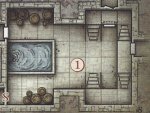doctorbadwolf
Heretic of The Seventh Circle
I would view spending "20 minutes describing every single feature of the room or area" as much of a failure on the part of the DM as describing so little that the players must ask questions to have enough context to act. Surely there is a middle ground here where the DM gives the basic scope of options sufficient for the players to have the context to act and does so in a reasonable amount of time. Or perhaps you are just exaggerating for effect here? Though to what end I can't guess.
I've explained it twice already in this thread: One is the player asking the DM a question and the DM answering. The other is the player describing what he or she wants the character to do and the DM narrating the result of the adventurer's action. The latter is in my view more in line with the basic conversation of the game as laid out in the Basic Rules and lends itself better to the flow of a story. And, at least in the case of the OP, it appears to make it easier for players to stay in character. @Lanliss says as much upthread.
From my perspective as a DM, when the Q&A is going on, the forward momentum of game play has stopped while the scene is being clarified, resuming only when the player has gotten sufficient context or pre-approval to act. Whereas when the player is describing what the character is doing, the momentum of game play continues uninterrupted, each action and result building on the next to flesh out the scene and create the emergent story.
But "I look at the tree to see how tall it is." Is a fake action. It's a weird veil thrown over what is actually happening, which is the player finding out what heir character already "knows", ie how tall the tree is. It's literally an added step. That just seems really weird, and I don't just mean ITT. I've encounter this tactic IRL, and it is so arbitrary and fakey to me that it *completely* kills immersion. I'm glad it works for you, I was just hoping that the explanation had more to it, so I was just missing something, it it seems that I wasn't. No big deal.
As for the time comment, there is a middle ground, and it includes allowing players to ask for clarification in the most efficient means possible.
The thing is, if you are in the habit of just letting the "q&a" happen, it effectively stops being out of character, because no one at the table thinks of it as a break in the action, and it resolves unanswered questions more quickly.

